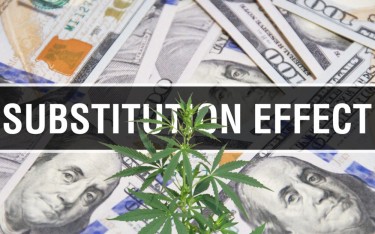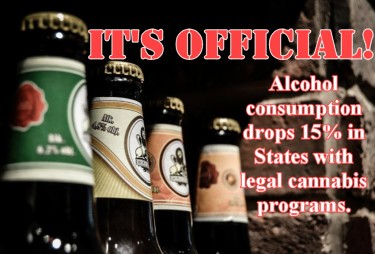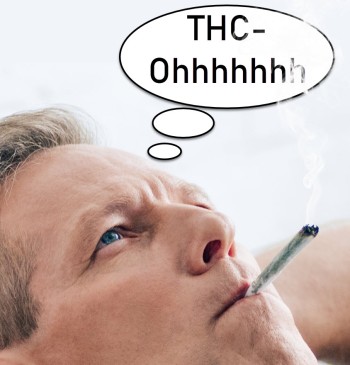
The Substitution Effect: How Legal Cannabis Is Reducing America's Alcohol Problem
When Dispensaries Open, Alcohol Sales Drop
New federally funded research from Oregon State University and the Oregon Public Health Division has confirmed what cannabis advocates have argued for years: legal access to marijuana reduces heavy alcohol consumption and can act as a substitution for other more dangerous narcotics. The study, published in the American Journal of Preventive Medicine and partially funded by the National Institute on Drug Abuse, analyzed data from over 61,000 Oregon residents between 2014 and 2022, finding that "odds of heavy alcohol use were lower with greater cannabis retail access, primarily among 21-24 and 65+ year olds."
This isn't just correlation—it's evidence of deliberate substitution. People living near dispensaries were choosing cannabis instead of alcohol, particularly the youngest legal adults and the oldest demographics. The researchers noted this pattern is "consistent with a substitution hypothesis" where marijuana availability creates a healthier alternative to drinking.
The implications are staggering. Alcohol kills approximately 140,000 Americans annually through liver disease, accidents, violence, poisoning, and chronic health conditions. It's implicated in 40% of violent crimes, costs the U.S. economy $249 billion in healthcare and lost productivity, and destroys families through addiction and abuse. If cannabis access can meaningfully reduce alcohol consumption—even modestly—we're talking about thousands of lives saved, billions in reduced costs, and measurable decreases in violence and suffering.
This article explores what happens when America's most destructive legal drug faces competition from a demonstrably safer alternative. What are alcohol's true costs? How does cannabis compare? And what would 10%, 25%, or even 50% reduction in alcohol consumption mean for public health, crime, and economics? The Oregon study provides the foundation for understanding what might be the most significant public health development of the 21st century: the voluntary substitution of cannabis for alcohol at a population scale.
The True Cost of Alcohol: America's Most Destructive Legal Drug
Alcohol's societal burden is so normalized that we rarely confront its full magnitude. Let's lay out the damage:
Death toll: Approximately 140,000 Americans die annually from alcohol-related causes. This includes 95,000 from chronic conditions like liver disease and alcohol-related cancers, plus another 45,000 from acute causes like poisoning, drunk driving accidents, and alcohol-induced violence. Alcohol is the third-leading preventable cause of death in the United States, behind only tobacco and poor diet/physical inactivity.
Violence and crime: Alcohol is present in roughly 40% of violent crimes, including 37% of rapes and sexual assaults, 27% of aggravated assaults, and 25% of simple assaults. Domestic violence correlates strongly with alcohol consumption—studies show 55% of domestic violence perpetrators were drinking at the time of assault. Alcohol doesn't just correlate with violence; it facilitates it by removing inhibitions, impairing judgment, and increasing aggression.
Drunk driving: Despite decades of enforcement and education, alcohol-impaired driving killed 13,524 people in 2023—37 deaths every day. Another 350,000 people were injured in alcohol-related crashes. The economic cost of drunk driving exceeds $44 billion annually in medical costs, legal expenses, lost productivity, and property damage.
Healthcare burden: Alcohol abuse and dependence create massive healthcare costs. Emergency departments treat 1.5 million alcohol-related visits annually. Chronic alcohol use causes liver cirrhosis (44,000 deaths yearly), pancreatitis, cardiovascular disease, various cancers, neurological damage, and weakened immune function. Fetal alcohol spectrum disorders affect 40,000 babies born annually in the U.S., causing lifelong cognitive and physical impairments.
Economic impact: The CDC estimates alcohol misuse costs the U.S. economy $249 billion annually—$807 per person. This includes $179 billion in lost workplace productivity (absenteeism, reduced performance, unemployment), $28 billion in healthcare expenses, $25 billion in criminal justice costs, and $17 billion in motor vehicle crash costs. These figures don't capture the full economic devastation of alcohol-related family disruption, child neglect, and lost human potential.
Addiction and dependency: An estimated 29.5 million Americans ages 12 and older had alcohol use disorder in 2021—10.6% of the population. Only 7.6% received any treatment. Alcohol withdrawal can be medically dangerous, potentially fatal, and requires supervised detoxification. The addiction cycle destroys careers, relationships, and lives while creating intergenerational trauma.
Social costs: Beyond quantifiable metrics, alcohol devastates families and communities. Children raised by alcoholic parents experience higher rates of abuse, neglect, and psychological trauma. Marriages collapse under the stress of alcohol dependence. Communities bear the burden of alcohol-fueled disorder—vandalism, public intoxication, noise complaints, and general dysfunction that degrades quality of life.
Alcohol's legal status and cultural normalization make us complacent about these costs. We accept alcohol-related deaths the way we accept weather-related deaths—regrettable but inevitable. But they're not inevitable. They're the predictable outcome of widespread use of a toxic, addictive, violence-facilitating substance that we've normalized to the point of invisibility.
Cannabis Comparison: Quantifying the Unquantifiable
Comparing cannabis's societal costs to alcohol's is challenging because cannabis has been prohibited for most of modern history, making comprehensive data scarce. What we do know suggests dramatically lower harm.
Death toll: Cannabis has never caused a fatal overdose. Zero. Ever. While smoking cannabis introduces combustion byproducts that carry some health risks, no credible research attributes significant mortality to cannabis use alone. The absence of fatal overdose risk fundamentally distinguishes cannabis from alcohol.
Violence and crime: Cannabis is not associated with increased violence. Depending on the study you’re citing, cannabis either increases or decreases violence. For the majority of people, cannabis reduces aggression rather than facilitating it. However, for certain people it can be a trigger. This is something that must be taking into consideration. However, compared to alcohol the violence-to-substance correlation is weak.
Impaired driving: Cannabis-impaired driving is problematic and potentially dangerous, but significantly less so than alcohol-impaired driving. Cannabis users demonstrate awareness of impairment and compensate by driving more cautiously, whereas alcohol users overestimate their capability and drive recklessly. Fatal crashes involving cannabis alone are far rarer than alcohol-involved crashes. Of course, this doesn’t mean you should smoke and drive, don’t be a statistic.
Healthcare burden: Cannabis use disorder exists but affects far fewer users than alcohol (about 9% of cannabis users develop dependency versus 23% of alcohol users). Cannabis doesn't cause organ failure, doesn't require medically supervised withdrawal, and doesn't create the systemic health devastation associated with chronic alcohol use. Emergency department visits for cannabis are overwhelmingly related to overconsumption anxiety rather than medical emergency.
Economic impact: No comprehensive study quantifies cannabis's economic cost equivalent to alcohol's $249 billion burden, largely because the harm profile is so much lower. Cannabis users maintain employment at rates comparable to or higher than the general population. Cannabis doesn't create the workplace productivity losses associated with alcohol hangover, dependence, and cognitive impairment.
Addiction potential: Cannabis use disorder is real but less severe and less common than alcohol dependence. Cannabis withdrawal is uncomfortable but not medically dangerous. Treatment success rates are higher, and functional recovery is more achievable.
The honest assessment: cannabis isn't harmless, but it's dramatically less harmful than alcohol across every measurable dimension. This harm differential is why substitution matters—people switching from alcohol to cannabis are making a significant harm reduction choice whether they consciously intend to or not.
The Substitution Scenarios: Lives, Dollars, and Freedom
Let's project what happens if legal cannabis access reduces alcohol consumption by 10%, 25%, and 50%. These aren't random numbers—the Oregon study showed measurable reductions in heavy drinking near dispensaries, and other research confirms substitution effects. Widespread legal access could plausibly achieve these reductions.
10% Reduction Scenario
If cannabis substitution reduces alcohol consumption by 10%, we're looking at:
-
14,000 lives saved annually (10% of 140,000 alcohol deaths)
-
$24.9 billion in reduced economic costs (10% of $249 billion annual burden)
-
5,400 fewer drunk driving deaths (10% of 54,000 alcohol-related traffic fatalities when including alcohol-involved non-driver deaths)
-
1.4 million fewer alcohol-related violent crimes (10% of 14 million alcohol-related offenses)
These are conservative, achievable numbers based on current substitution trends. A 10% reduction is modest—the Oregon study showed significant effects in areas with high dispensary density, suggesting larger reductions are possible as access expands.
25% Reduction Scenario
A 25% reduction represents meaningful population-level substitution—roughly what we might expect if cannabis legalization reaches all 50 states with mature retail markets:
-
35,000 lives saved annually
-
$62.25 billion in reduced costs
-
13,500 fewer drunk driving deaths
-
3.5 million fewer alcohol-related violent crimes
-
7.4 million fewer Americans with alcohol use disorder (25% of 29.5 million)
This scenario transforms public health outcomes. We're talking about preventing more deaths than automobile accidents cause, reducing violent crime by an amount exceeding the entire annual crime rate in many states, and alleviating healthcare systems of massive alcohol-related burden.
50% Reduction Scenario
A 50% reduction is ambitious but not impossible if cannabis becomes the dominant recreational substance—as our previous article discussed, cannabis use is already overtaking cigarettes:
-
70,000 lives saved annually
-
$124.5 billion in reduced costs
-
27,000 fewer drunk driving deaths
-
7 million fewer alcohol-related violent crimes
-
14.75 million fewer Americans with alcohol use disorder
This scenario represents wholesale cultural transformation where cannabis largely replaces alcohol as America's recreational substance of choice. It's speculative, but the Oregon data shows this trajectory is possible.
The Caveats: What We Don't Know About Cannabis Substitution
These projections assume cannabis doesn't create equivalent harms, which seems supported by available evidence but requires honesty about uncertainties. Cannabis isn't harm-free. Heavy cannabis use can impair cognitive function, particularly in developing brains. Cannabis use disorder, while less common and severe than alcohol dependence, is real. Cannabis-impaired driving is dangerous even if less dangerous than drunk driving.
We also don't know long-term population health effects of widespread cannabis use. Most research examines users in prohibition contexts—what happens when 30-40% of the population uses cannabis regularly in legal frameworks? We're finding out in real-time as legalization expands.
There's also the complacency question: does cannabis reduce motivation, civic engagement, or productivity at scale? Does a "stoned nation" lose competitive edge, innovation, or social cohesion? The data doesn't suggest this—cannabis-using populations show normal employment rates and civic participation—but it's worth monitoring.
Finally, substitution isn't universal. Some people will use both cannabis and alcohol. Some will increase cannabis use without decreasing alcohol. Individual responses vary, and population-level trends don't predict individual outcomes.
The Sticky Bottom Line: Evidence of Harm Reduction at Scale
The Oregon study provides empirical evidence that legal cannabis access reduces heavy alcohol consumption. This isn't theory—it's measured reality in a state with mature legal markets and comprehensive data collection. The substitution effect is real, measurable, and most pronounced in the youngest and oldest adult demographics.
Given alcohol's massive societal costs—140,000 annual deaths, $249 billion economic burden, millions of violent crimes—even modest reductions through cannabis substitution represent enormous public health victories. A 10% reduction saves 14,000 lives yearly. A 25% reduction saves 35,000 lives and $62 billion. These aren't abstract statistics—they're prevented tragedies, intact families, and communities freed from alcohol-related violence and dysfunction.
Cannabis isn't a perfect substitute. It carries its own risks that require honest assessment and appropriate regulation. But compared to alcohol, cannabis is dramatically safer across every measurable dimension. The harm differential means that substitution, even incomplete substitution, reduces population-level harm.
The question facing policymakers isn't whether cannabis substitution happens—the Oregon study confirms it does. The question is whether we'll facilitate this harm reduction through expanded legal access or obstruct it through continued prohibition that forces people back toward alcohol.
The data points toward an uncomfortable truth for alcohol industries and prohibition advocates: cannabis availability makes people drink less, and that makes society measurably safer. Every dispensary that opens represents potential lives saved from alcohol-related harm. That's not drug warrior rhetoric—it's evidence-based public health reality demonstrated by federally funded research.
We can either acknowledge this evidence and adjust policy accordingly, or we can maintain prohibition while people continue dying from alcohol-related causes that cannabis substitution could prevent. The Oregon study makes the moral calculus clear: legal cannabis access is harm reduction at a population scale. The only question is whether we're willing to embrace it.
ALCOHOL SALES DROP WITH LEGAL CANNABIS, READ ON...
ALCOHOL SALES DROP 15% IN STATES WITH JUST MEDICAL CANNABIS!






